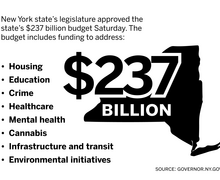West Side story: St. Joseph’s Hospital facility offers improved care for local residents
Luke Rafferty | Video Editor
Doctors started seeing patients at the expanded St. Joseph's West Side Family Center Monday.
Correction: In a Jan. 22 article titled “West Side Story: St. Joseph’s Hospital facility offers improved care for local residents,” the facility’s office hours were misstated. The Westside Family Health Center is open Monday, Tuesday, Thursday and Friday from 8:30 a.m. to 5:00 p.m. and Wednesdays from 9:30 a.m. to 6:00 p.m. The Daily Orange regrets this error.
St. Joseph’s Hospital Health Center, a major system in the Syracuse area, began servicing patients at a recently opened location on Syracuse’s West Side Monday.
St. Joseph’s West Side Family Center is the most recent in a series of updates for St. Joseph’s, including renovations to existing hospitals, in order to provide primary care to more Syracuse locals. St. Joseph’s West’s one-story,16,000-square-foot facility houses 24 exam rooms, more than three times as many as the old West Side center, and is designed to hold a second floor if an expansion is needed.
Labeled as a “primary care center,” St. Joseph’s West places an emphasis on food and nutrition education for low-income families and individuals, which comprised more than 75 percent of the center’s patients in 2012. Syracuse’s West Side is one of the city’s poorest neighborhoods, with a predominantly working class and refugee demographic that often have Medicare, Medicaid or no insurance at all, according to a Jan.15 article on Syracuse.com.
“To these patients, the Primary Care Center is more than just a healthcare facility — it is a lifeline in times of crisis, a safe haven offering dignity and respect as well as quality health care,” said Kerri Howell, director of public relations and marketing at St. Joseph’s Hospital Health Center, in a statement.
Bob Seigart, the partner in charge of the project at Schopfer Architects, said even if a deal had been struck with their landlord, the building didn’t lend itself to expansion. Ultimately, the demand for care required a larger facility.
“It’s a little larger than most family health centers, but frankly, it’s well warranted,” Seigart said. “They were in a 4,000 square foot building and they already knew, because of the need of the West Side, that that (building) was woefully inadequate.”
Apart from the smaller size, the previous building lacked “space and support services, such as lab, imaging and behavioral health” that was becoming necessary to properly care for the nearly 9,000 annual patients, Howell said.
“The whole system is (centered) around family care,” added Marylin Galimi, director of engineering and construction at St. Joseph’s. “Pediatrics, behavioral health and adult services all under the same roof to be able to take care of the whole family.”
In order to encourage healthy eating, St. Joseph’s West worked with Paul Nojaim, owner of the neighboring Nojaim Brothers supermarket, to create a clinical and nutritional program. Customers at Nojaim Brothers earn points for purchasing healthy foods. Eligible patients can enter to win gym memberships, bikes and other rewards meant to promote a healthier lifestyle.
“The doctors can prescribe change and I can reward you for changing,” Nojaim said.
Marilyn Higgins, vice president of economic development at Syracuse University, said she believes the partnership between Nojaims’ supermarket and the health center is going to make it possible to provide “one of the best grassroots neighborhood health plans in the country.”
Higgins added that she’d never seen this kind of collaboration between a neighborhood grocery store with a comprehensive health clinic.
She also said the collaboration would provide food studies and nutrition students in the David B. Falk School of Sport and Human Dynamics with unprecedented internship opportunities.
While construction officially began in early 2013, Seigart said Schopfer and St. Joseph’s had planned to build the family center since the summer of 2011. The new hospital was funded using a $4.9 million state-sponsored HEAL-NY phase 11 grant, Howell said. Howell added that building the hospital did not raise taxes on anyone in the area.
“It’s no different than how we are doing things right now, ” said Galimi. “Right now, we really don’t turn away anyone that needs care.”
Published on January 22, 2014 at 2:45 am




